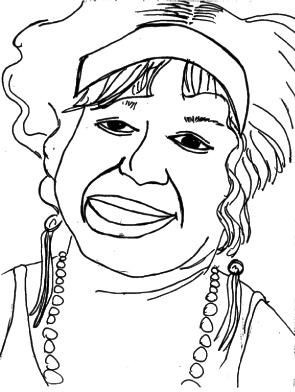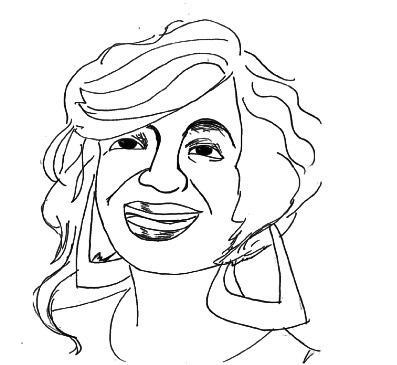sheryl-ann simpson
(((Sheryl-Ann is a student of city and regional planning who mostly researches questions of urban inequality and community organizing and activism. She also makes and organizes weird little performances and interventions that celebrate the everyday. This zine is one of those rare moments where the two get to come together.)))
This zine was presented during the Art in Action exhibition as part of Study in Action 2012, Montreal. To view more of the series go to http://flic.kr/ps/QTUB8
Sooooo this zine sort of came out of a blog post I wrote for a job I don’t have anymore, and that never actually got posted at least in part because my old boss was… well let’s say ‘incompetent,’ but at any rate the post was complaining about Chris Rock’s movie Good Hair, and I include it below, but basically the point is the zine has almost nothing to do with hair, hope you’re not too disappointed.
Disclaimer, I’m going to to that thing I hate where you complain about a movie before you’ve seen it, but here goes: I’m just not very excited about Chris Rock’s Good Hair.
To be honest I’m a bit bored of movies made by men about women, but more importantly what’s up with the media continuing to obsess over Black women’s bodies while they completely ignore our lives. Sometimes it’s pretty benign and we just miss out on an interesting conversation. One example that Tokumba Bodunde and Courntey Young pointed out during their session at WAM! 2009 was the controversy surrounding Michelle Obama’s official portrait. So much time was spent talking about her arms that no one seemed to have time to ask about the choice to have Thomas Jefferson staring down at her in the background.
There are also more intrusive conversations about Black women’s bodies that end up impacting lives in more consequential ways, for example providing the justifications behind welfare laws that aim to control everything from what women eat to who they do, do not sleep with and marry, and their choices to have or not have children.
The story behind Good Hair is that Chris Rock’s daughter came home one day wanting to know why she didn’t have ‘good hair’, and I understand it’s satire, but I’m just not sure how a movie where her dad warns a young woman in India that ‘if she ever sees a Black woman she should run’ or risk having her hair stolen is really going to improve his daughter’s choices as she grows up.
And frankly I’m not sure if it does more good than harm to introduce another opportunity for people to sit around and talk about women, women of colour and Black women’s bodies. I can’t help but think it would be be better if white men* and others, would spend their time learning to understand the history of Black women as workers, thinkers, caregivers, artists … rather than sorting out the difference between cornrows and weaves.
So here’s a chance. Enjoy!!
*this whole tirade was pretty much just a reaction to a pre-review by Channing Kennedy at RaceWire that you can read at [http://colorlines.com/archives/2009/08/chris_rocks_good_hair_could_se.html] and then maybe join me in a big what now?!
angela davis
Angela exists in an in-between world of being a public figure (read famous), an amazingly well-respected academic and revolutionary turned continued and committed activist. Former Black Panther caught up in the arrests and FBI searches of 1970, Angela grew up in the same Birmingham community as Condoleezza Rice, but obviously went in a very different direction. A prof. at Santa Cruz and strong supporter of the prison abolition organization Critical Resistance, she’s basically just amazing, and you should know about her!!
“It is both humiliating and humbling to discover that a single generation after the events that constituted me as a public personality, I am remembered as a hairdo.”
trey anthony
OK this one was hard, because this isn’t really a drawing of Trey, but of the character Joy who Trey created for her award winning play and then TV series: ‘Da Kink in My Hair’. I’ve never seen the play, but the TV show is a deeply funny show ostensibly about a Jamaican hair dressing shop in Toronto, but it’s really about everything you don’t talk about in the West Indian community: mental health, abuse, queer folks, inter-raced families and relationships, and everything you do: food, gossip and of course which island in the best island. Trey credits coming out to her family as a huge part of writing the play and lives her everyday life with thin tight dreads. Joy is boy-mad and wears a different bright, elaborate wig everyday!
Also, every Black actress/actor, singer, dancer, spoken word artist etc in all of Canada seems to make an appearance on the show.
ma rainey

Ma Rainey was born in Columbus Georgia in 1886, the perfect moment to bring the world the blues before it was even the blues. In 1904 Gertrude Pridett married Will “Pa” Rainey and soon after she started a career of vaudeville and recording that saw her travel extensively around the south and the northeast. She drew in huge crowds (both Black and white even in the south) as a performer, and as a recording artist she worked with then young artists such as Bessie Smith, and T Bone Walker.
One of her hits “Sissy Blues”, is a blues about having her man stolen by a sissy who she just can’t compete with. Sissy’s not an insult here, just a description of her no doubt fabulous male competition. And a friend pointed out that it’s a pretty good example of just how everyday queer culture was in African American life back in the day.
In the 1930s her career began to slow down as talking pictures killed off vaudeville. She moved back to Georgia in 1935 and passed away in 1939, and sad-but-true, in spite of her many successes her death certificate registered her occupation as housekeeper. But we all know she was the mother of the blues – who felt that the blues “were expressive of the heart of the south, and the sad hearted people who toiled from sun-up to sundown.”
sylvia hamilton

Growing up in Toronto or Montreal, it might be easy to believe that Black Canada started in the 1970s with West Indian, and African immigrants. Growing up in the prairies it’s a bit harder to believe that, but in Nova Soctia it’s absolutely impossible to labour under this misconception.
The history of Black Nova Scotia is a rich one, with freed Canadian slaves, as well as Loyalists, escaping slaves and refugees from the US, and Sylvia Hamilton’s films tell the story of where their decedents are today. Her films give you the opportunity to eavesdrop on some of the best conversations, from her early shorts about Black mums and daughters, to her later films about all-Black schools in Nova Scotia. She’s the kind of filmmaker who manages to get out of the way, and let people speak about their own experiences and histories in their own words.
Take a look for yourself at the the National Film Board site (which is just generally so amazing!) www.nfb.ca/explore-all-directors/sylvia-hamilton
Also look her up on wikipedia, which you couldn’t do a few months ago en.wikipedia.org/wiki/Sylvia_Hamiton



